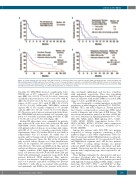Page 249 - 2021_03-Haematologica-web
P. 249
Letters to the Editor
AB
CD
Figure 1. Overall survival (OS). (A) Patients (pts) with relapsed or refractory (R/R) acute myeloid leukemia (AML) following front-line venetoclax (VEN) and hypomethylating agent (HMA) regimens, (B) according to receipt of salvage therapy; (C) patients receiving front-line HMA and VEN compared to front-line inten- sive chemotherapy in a population matched for age and European LeukemiaNet 2017 cytogenetic risk status; (D) patients with R/R disease after front-line HMA and VEN versus intensive chemotherapy. n: number; HR: hazard ratio; CI: confidence interval.
front-line IC, VEN+HMA showed a significantly better CR/CRi rate of 87% compared to 59% with IC (odds ratio [OR] 3.29, 95%CI: 1.79-6.01; P=0.0001), lower rate of primary refractory disease of 8% versus 24% with IC (OR 0.32, 95%CI: 0.14-0.74; P<0.01), and a lower rate of relapse of 42% versus 58% with IC (OR 0.52, 95%CI: 0.30-0.90; P=0.02). Additionally, VEN+HMA conferred superior OS of 15.1 months compared to 8.1 months with IC (HR 0.57, 95%CI: 0.44-0.75; P<0.001) (Figure 1C). However, and of interest, patients who failed front- line VEN+HMA had shorter survival of 2.3 months com- pared to 3.6 months in patients failing front-line IC (HR 1.76, 95%CI: 1.10-2.77; P<0.005) (Figure 1D).
Median OS after relapse were comparable for patients who achieved CR versus those who achieved CRi with VEN+HMA (Online Supplementary Figure S2). Patients with primary refractory disease versus relapse had compa- rable OS of 1.7 versus 2.3 months, respectively (Online Supplementary Figure S3). Median OS for de novo AML at relapse/failure was 2.5 months, for sAML was 2.8 months, and for therapy-related (t-AML) was 1.1 months (Online Supplementary Figure S4). Out of the 24 patients who received salvage therapy (see Online Supplementary Table S2 for regimens), five patients (21%) responded with CR (n=1), CRi (n=2), and MLFS (n=2). One patient underwent allogeneic stem-cell transplantation in second complete remission (CR2). Eight patients received IC, and 2 of 8 patients achieved CR and CRi with CLIA and CLIA with gemtuzumab ozogamicin, respectively. Both patients harbored NRAS mutations. Nine patients received non-intensive chemotherapy-based regimens, and 3 of 9 patients responded, including two patients with FLT3mut, with CRi in one patient with azacitidine and quizartinib, and MLFS in two patients with azaciti-
dine, nivolumab, ipilimumab, and low-dose cytarabine with quizartinib, respectively. These five responding patients (Figure 2 and Online Supplementary Table S2) con- tinue in remission with median DOR not reached (NR) (range 0.7-20.1) and OS NR (range, 2-21.2).
The most frequently occurring mutations in this R/R population, at initial diagnosis, included TP53, DNMT3A, N/KRAS, TET2, and ASXL1 (Figure 2). Twenty patients had 81-gene next-generation sequencing (NGS) panel results at diagnosis and at the time of R/R disease. The most frequent mutations gained at the time of R/R dis- ease were mutations in signaling pathways (30%, NF1, FLT3-ITD, NRAS, JAK1), RNA splicing (30%, U2AF1, U2AF2, SRSF2, ZRSR2), transcription factors (30%, IKZF1, SETBP1, RUNX1, STAT5A), tumor suppressors (15% TP53, WT1), and epigenetic modifiers (10%, BCOR, CREBBP).
Among five patients with FLT3-ITD, two patients responded to salvage regimens containing a FLT3 inhibitor (Figure 2 and Online Supplementary Table S3). Out of ten patients with K/NRAS mutations receiving sal- vage therapy, three patients (30%) responded to IC (n=2) and HMA-based regimens (n=1). Of the five patients with TP53mut receiving salvage therapy, one patient achieved MLFS with azacitidine, nivolumab and ipili- mumab. This patient was also the only one among seven patients with complex karyotype who responded to sal- vage therapy.
These findings summarize the characteristics and poor outcomes of patients who develop R/R disease after front-line VEN+HMA therapy. These patients presented with high-risk biology including t-AML, sAML, complex karyotype, FLT3-ITDmut, TP53mut, and N/KRASmut at diag- nosis and also evolved with treatment. Patients who
haematologica | 2021; 106(3)
895


